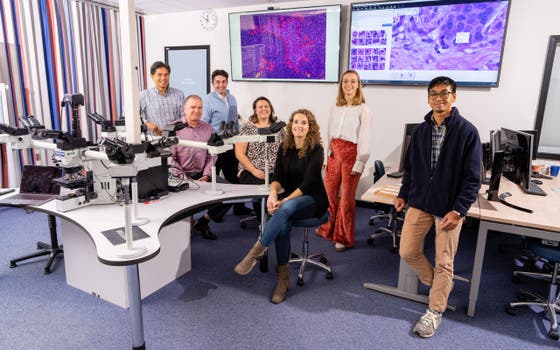AI helps pathologists at UMC Utrecht detect metastases in breast cancer faster and cheaper

Research from UMC Utrecht shows that AI can help pathologists perform sentinel node assessment more efficiently. This assessment is performed to detect breast cancer metastases. Implementing AI assistance for the detection of these metastases is safe, it significantly reduces costs, it saves pathologists time and it makes their work more enjoyable. The research group's findings were published today in the scientific journal Nature Cancer.
"Healthcare demand and healthcare costs are rising dramatically, and there is already a worldwide shortage of pathologists," says postdoc and clinical epidemiologist Carmen van Dooijeweert. "With AI, pathologists need to spend less time for the assessment of lymph nodes AND we save costs (win-win), while diagnostics remain just as safe for patients. We like this because it shows that if you implement AI in this safe manner, you not only save money and time, but you also make pathologists' work a lot more enjoyable right away."
AI recognizes metastases faster (and cheaper)
After a woman's breast tumor is removed for breast cancer, often the sentinel lymph node is also removed. By doing so, the pathologist can check if the cancer has metastasized. That is, if breast cancer starts spreading, the tumor cells end up in that sentinel lymph node first, via the lymph fluid. That is why pathologists always carefully examine that tissue as well.
At UMC Utrecht, since the implementation of digital pathology in 2015, this is no longer done with a microscope, but behind a computer screen.
Sometimes pathologists see those metastases by eye, but the smaller the metastasis, the more difficult this is. Moreover, to do so, they have to look at all the sections very carefully. If no metastases are detected, pathologists look at sections (thin slices) of the sentinel lymph node one more time, to make sure they don't miss any metastases. This second time, they use additional staining with antibodies that recognize tumor-specific proteins (immunohistochemistry).
"Because these antibodies have a color label, the tumor cells become clearly visible," Carmen continues. "This allows you to see if there are still tumor cells that were missed during the initial assessment, without the extra staining. However, those extra stains are quite expensive, at about 25 euros per tissue section, of which we already do (at least) five per sentinel node. Also, sometimes multiple tissue blocks from multiple sentinel lymph nodes need to be viewed, and then the costs rise quickly. In addition, it is also an intensive and time-consuming job for the pathologist."
Faster and cheaper?
During the CONFIDENT-B trial, Carmen investigated whether AI can help perform sentinel node tissue assessment more efficiently. Can it be done faster and, with rising healthcare costs in mind, cheaper, without risking missing tumor cells when omitting the additional staining?
"You can actually use AI in two ways: completely independent ('independent AI' - ed.) or as a helper to the healthcare professional ('AI assistance - ed.)," Carmen explains. "With Independent AI, the algorithm decides completely independent whether something is a tumor or not. This is risky and it is currently unthinkable in clinical practice because what if the algorithm is wrong? That raises all kinds of ethical and legal questions.
Instead, Carmen and her team used that other form of artificial intelligence, AI assistance. AI then helps you, but you still have to look at the result yourself. So a pathologist still looks at the slides in all cases (human in the loop).
"Our AI-application – which we did not develop ourselves, but we licensed it from the company Visiopharm– recognizes structures," Carmen says. "It recognizes anything which doesn’t belong in a lymph node and marks it for the pathologist. The algorithm then puts a red, orange or yellow outline around it, depending on how suspicious it thinks the spot is."
Innovation that lowers healthcare costs
For the trial, Carmen worked with two groups of sentinel nodes. For one group, the standard procedure was followed, and for the other group, AI was used first. For the AI group, Carmen rand the AI-application, and then the pathologists looked specifically at the outlines. That check was quickly completed for the pathologists, often without the need for expensive additional staining.
And what did it reveal? Less time was needed in the AI group, and it turned out to be much cheaper to work that way. "During the trial, we have already saved 3,000 euros on additional stainings. That can add up to tens of thousands of euros per year," Carmen says.
The amount saved only increases when you consider that in some hospitals, the expensive extra stainings are often performed immediately in order to work faster. Several (cost-saving) scenarios were also calculated in the paper, allowing other pathology laboratories to calculate for themselves the potential cost savings when using AI for this application.
Of course, checks were performed during the trial to ensure that the AI procedure was safe: in all cases where no tumor cells were detected, the additional staining was still performed, and AI turned out to have done its work correctly. In addition, the unanimous conclusion of the participating pathologists was that working with the algorithm makes their work more enjoyable.
Paul van Diest, department head of pathology and research leader: "This study has shown that with AI we can detect metastases in lymph nodes safely, faster and cheaper. This contributes greatly to the business case for introducing AI in pathology, because unfortunately and unfairly there is no reimbursement for it yet."
The pathologists at UMC Utrecht are now working this way as standard in breast cancer, probably as the first in the world.
